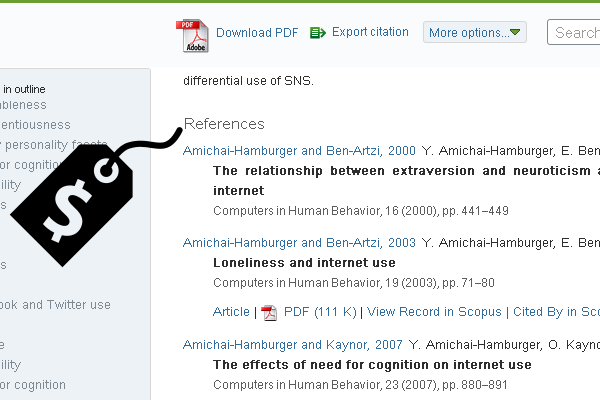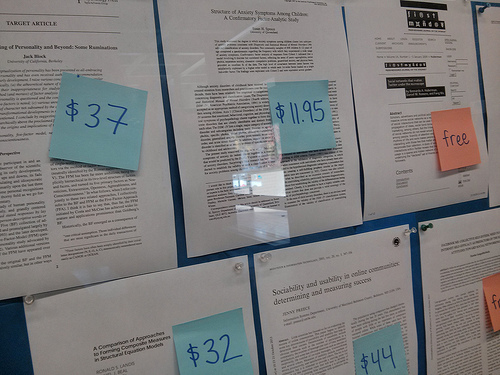
It's Open Access Week and to celebrate, I thought I would try to calculate how much it would cost for me to read an article and its bibliography if I couldn't rely on the subscriptions that the Leddy Library currently pays for.
To understand why I did this, you it helps to understand a little bit about Open Access. I like the definition of Open Access that Peter Suber has developed. (Peter Suber is a philosopher who now works in the Harvard Office for Scholarly Communication). He provides a fairly long definition - so here's a shorten version:
Open-access (OA) literature is digital, online, free of charge, and free of most copyright and licensing restrictions.
OA is compatible with copyright, peer review, revenue (even profit), print, preservation, prestige, quality, career-advancement, indexing, and other features and supportive services associated with conventional scholarly literature.
The primary difference is that the bills are not paid by readers and hence do not function as access barriers.
Scholarly works are increasingly Open Access but it's still not the norm and different disciplines have different rates of Open Access adoption.
I suspect that one small reason why adoption is slow (but steady) is that active scholars don't always realize or appreciate how much access to scholarly literature can cost an individual who cannot benefit from library subscriptions to scholarly journals and who must shoulder the costs themselves. There are citizens who are unhappy that they help indirectly fund public research through taxation but are not able to access said research. A case in point:
My rule: paywalled science pubs about breast cancer research should be free for people who have breast cancer whose lives depend on research
— Xeni Jardin (@xeni) October 18, 2013
To be honest, I was personally unsure how much each of the major scholarly publishers did charge for per article access and so that's why I went through this exercise: I found an article about a topic I was interested in and then found out how much each article it cited in its bibliography would cost if I had to purchase access.
And nowI know this: The cost of all papers cited in this article totaled $704.15 USD
Hughes, D. J., Rowe, M., Batey, M., & Lee, A. (2012). A tale of two sites: Twitter vs. Facebook and the personality predictors of social media usage. Computers in Human Behavior, 28(2), 561–569. doi:10.1016/j.chb.2011.11.001,
(You can see how the costs add up the bottom of this post)
The authors and reviewers of the paper in question are not directly financially compensated for the work involved in the the writing and peer-review of the work.
The publisher of the paper that I've highlighted here is the company Reed Elsevier.
Reed Elsevier leads the global market for scientific and technical publishers with 2012 revenue of $1.78 billion, a 3.1% increase from $1.72 billion in 2011.
Reed Elsevier accounts for 16.5% of the scientific and technical publishing market, which is almost equal to the next three competitors combined:
• Thomson Reuters: 6.2%,
• Springer Science + Business Media: 5.4 %
• John Wiley & Sons: 5.4%.
“All are in the for-profit sector, and the profits are enormous. As reported in the Economist (2011): “Elsevier, the biggest publisher of journals with almost 2,000 titles, cruised through the recession. Last year it made £724m ($1.1 billion) on revenues of £2 billion—an operating-profit margin of 36%”. Springer’s Science + Business Media (2010) reported a return on sales (operating profit) of 33.9% or € 294 million on revenue of € 866 million, an increase of 4% over the profit of the previous year. In the first quarter of 2012, John Wiley & Sons (2011) reported profit of $106 million for their scientific, medical, technical and scholarly division on revenue of $253 million, a profit rate of 42%. This represents an increase in the profit rate of 13% over the previous year.”
Morrison, Heather (2011). Chapter two: scholarly communication in crisis. Freedom for scholarship in the internet age. PhD Dissertation in progress.
"You just have to ask yourself whether that’s where you want your money going."
And because I believe that I should show my work here's exactly how reading the works within one bibliography could cost you $704.15 USD

Amichai-Hamburger, Y., & Ben-Artzi, E. (2003). Loneliness and Internet use. Computers in Human Behavior, 19(1), 71–80. $19.95
Amichai-Hamburger, Y., Kaynar, O., & Fine, A. (2007). The effects of need for cognition on Internet use. Computers in Human Behavior, 23(1), 880–891. $19.95
Amichai-Hamburger, Y., & Vinitzky, G. (2010). Social network use and personality. Computers in Human Behavior, 26(6), 1289–1295. $19.95
Amiel, T., & Sargent, S. L. (2004). Individual differences in Internet usage motives. Computers in Human Behavior, 20(6), 711–726. $19.95
Bas, V. (1993). Need for cognition and external information search: Responses to time pressure during decision-making. Journal of Research in Personality, 27(3), 238–252. $39.95
Bentler, P. M., & Bonett, D. G. (1980). Significance tests and goodness of fit in the analysis of covariance structures. Psychological Bulletin, 88(3), 588–606. $11.95
Block, J. (1995). A contrarian view of the five-factor approach to personality description. Psychological Bulletin, 117(2), 187–215. $11.95
Block, J. (2010). The five-factor framing of personality and beyond: Some ruminations. Psychological Inquiry, 21(1), 2–25. $37
Butt, S., & Phillips, J. G. (2008). Personality and self reported mobile phone use. Computers in Human Behavior, 24(2), 346–360. $19.95
Cacioppo, J. T., & Petty, R. E. (1982). The need for cognition. Journal of Personality and Social Psychology, 42(1), 116–131. $11.95
Cacioppo, J. T., Petty, R. E., & Kao, C. F. (1984). The efficient assessment of need for cognition. Journal of Personality Assessment, 48(June), 306–307. $37
Coffman, D. L., & MacCallum, R. C. (2005). Using parcels to convert path analysis models into latent variable models. Multivariate Behavioral Research, 40(2), 235–259. $37
Correa, T., Hinsley, A. W., & de Zúñiga, H. G. (2010). Who interacts on the Web?: The intersection of users’ personality and social media use. Computers in Human Behavior, 26(2), 247–253. $19.95
Das, S., Echambadi, R., McCardle, M., & Luckett, M. (2003). The effect of interpersonal trust, need for cognition, and social loneliness on shopping, information seeking and surfing on the Web. Marketing Letters, 14(3), 185–202. $39.95
Fornell, C., & Larcker, D. F. (1981). Evaluating structural equation models with unobservable variables and measurement error. Journal of Marketing Research, 18(February), 39–50. $24
Gangadharbatla, H. (2008). Facebook Me: Collective Self-Esteem, Need to Belong, and Internet Self-Efficacy as Predictors of the Igeneration’s Attitudes toward Social Networking Sites. Journal of Interactive Advertising, 8(2), 1–28. open access
Goldberg, L. R. (1990). An Alternative “Description of Personality”: The Big-Five Factor Structure. Journal of Personality and Social Psychology, 59(6), 1216–1229. $11.95
Gosling, S. D., Vazire, S., Srivastava, S., & John, O. P. (2004). Should We Trust Web-Based Studies? A Comparative Analysis of Six Preconceptions About Internet Questionnaires. American Psychologist, 59(2), 93–104. $11.95
Hamburger, Y. A., & Ben-Artzi, E. (2000). Relationship between extraversion and neuroticism and the different uses of the Internet. Computers in Human Behavior, 16(4), 441–449. $19.95
Hu, L.-T., & Bentler, P. M. (1999). Cutoff criteria for fit indexes in covariance structure analysis: Conventional criteria versus new alternatives. Structural Equation Modeling, 6(1), 1–55. $37
Huberman, B. A., Romero, D. M., & Wu, F. (2009). Social networks that matter Twitter under the microscope. First Monday, 14(1). open access
Landis, R. S., Beal, D. J., & Tesluk, P. E. (2000). A Comparison of Approaches to Forming Composite Measures in Structural Equation Models. Organizational Research Methods, 3(2), 186–207. $32
Lee, K., & Ashton, M. C. (2004). Psychometric properties of the HEXACO personality inventory. Multivariate Behavioral Research, 39(2 SPEC. ISS.), 329–358. $37
McCrae, R. R., & Costa Jr., P. T. (1987). Validation of the Five-Factor Model of Personality Across Instruments and Observers. Journal of Personality and Social Psychology, 52(1), 81–90. $11.95
McElroy, J. C., Hendrickson, A. R., Townsend, A. M., & DeMarie, S. M. (2007). Dispositional factors in internet use: Personality versus cognitive style. MIS Quarterly: Management Information Systems, 31(4), 809–820. $14
Podsakoff, P. M., MacKenzie, S. B., Lee, J.-Y., & Podsakoff, N. P. (2003). Common Method Biases in Behavioral Research: A Critical Review of the Literature and Recommended Remedies. Journal of Applied Psychology, 88(5), 879–903. $11.95
Preece, J. (2001). Sociability and usability in online communities: Determining and measuring success. Behaviour and Information Technology, 20(5), 347–356. $44
Raacke, J., & Bonds-Raacke, J. (2008). MySpace and facebook: Applying the uses and gratifications theory to exploring friend-networking sites. Cyberpsychology and Behavior, 11(2), 169–174. $51
Ross, C., Orr, E. S., Sisic, M., Arseneault, J. M., Simmering, M. G., & Orr, R. R. (2009). Personality and motivations associated with Facebook use. Computers in Human Behavior, 25(2), 578–586. open access
Ryan, T., & Xenos, S. (2011). Who uses Facebook? An investigation into the relationship between the Big Five, shyness, narcissism, loneliness, and Facebook usage. Computers in Human Behavior, 27(5), 1658–1664. open access
Spence, S. H. (1997). Structure of anxiety symptoms among children: A confirmatory factor- analytic study. Journal of Abnormal Psychology, 106(2), 280–297. $11.95
Tuten, T. L. (2001). Understanding differences in web usage: The role of need for cognition and the five factor model of personality. Social Behavior and Personality, 29(4), 391–398. $39
Open Access Week is about celebrating the alternatives to the status quo and about imaging what could happen if the cost of knowledge was not set so high.
Price Tag designed by Atelier Iceberg from The Noun Project

Connect with your library